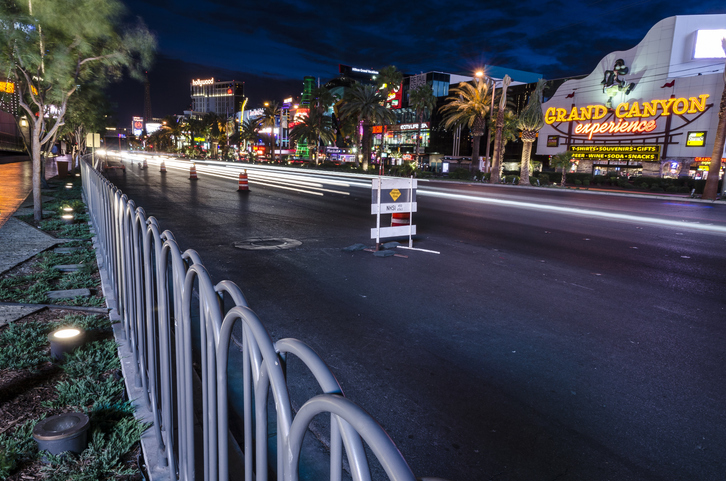Road Construction May Be Worse Than Ever In Las Vegas — Here’s How To Avoid It
Safety Info October 11, 2021 0 COMMENTS
Transportation network development in Las Vegas may have slowed down during the recession and immediately after due to the lack of enough funding, but the work has picked up pace in recent years.
With funding pouring in from various sources along with the general economic growth of the city, infrastructure development and road improvement projects have seen a spike. Several projects stalled due to the recession have been restarted to keep up with the growing infrastructure needs.
But this has posed a new problem for the commuters. With construction materials piling up in several places over the city, proper navigation through the roads has become difficult.
Dealing With The Pending Infrastructure Projects
The recession did not result in a complete termination of all infrastructure-related projects. According to Larry Brown, a Clark County commissioner as well as the chairman of the Regional Transportation Commission of Southern Nevada, some work was done during the recession period. Although there wasn’t a total standstill, there was a lack of resources to start all the required projects.
At present, the funding for road construction and infrastructure development comes from multiple sources, including the local government and the RTC (Regional Transportation Commission). This increased funding has ensured that new projects have started, as well as the resumption of the pending ones.
The current projects in Las Vegas aren’t confined solely to road development or maintenance. Flood control, sewer up-gradation, and infrastructure adjustments constitute a large portion of the ongoing work.
All of these projects together are responsible for the obstructions on the roads. While a large number of projects are short-term, the current volume makes the smooth management of traffic difficult.
Traffic-Related Problems
While the officials in charge of the work try their best to not create any problems for the commuters, the large number of projects make it very difficult to avoid traffic issues.
The manager of engineering at the RTC, John Penuelas, talked about how they all try to look out for the traveling public. One way of doing so is by combining multiple projects for the same area together to save commuters’ time.
For example, the Las Vegas Valley Water District had a project underway for replacing the concrete pipes of the Convention Center Drive with plastic ones. At the same time, Clark County was due to begin a project of repairing the road and widening the sidewalks of the same area. Officials decided to take on the projects simultaneously so that the commuters wouldn’t have to navigate multiple projects in a row.
In addition, any NDOT (Nevada Department of Transportation) project that may restrict access to the roads requires public notice and community outreach well in advance.
But, in spite of all such measures, traffic delays are very common. In fact, traffic congestion often leads to crashes or accidents. As a result, the role of Las Vegas Car Accident Attorneys has become increasingly important in enabling the victims to receive their rightful compensation.
How Can Drivers Deal With It?
Getting stuck in a traffic jam can be really frustrating, especially when you have to reach your workplace or have an urgent appointment. However, driving in a hurry or trying to overtake the car in front hastily can cause accidents.
The best way to deal with such situations is to remain calm. Do not try to get out of the car to check the situation in front. This can be dangerous as there is a chance you’ll get hit by any vehicle trying to get into the gap from behind.
Turning off your engine is a good idea to save fuel, especially if you feel that the congestion won’t be clearing too soon. But no matter what, stay alert of traffic movements in front so that you can get out of the congested area as soon as possible. Taking a detour is also a good idea to avoid potentially congested roads.
RELATED ARTICLES
Recent Posts
- Major Theft Ring Busted: Over $200,000 in Stolen Lego Sets Recovered in Eugene, Oregon
- Judge Denies Texas’ Bid to Shut Down Migrant Shelter Network in El Paso
- Single Mother in Memphis Seeks Help for Troubled Son Amid Rising Concerns
- California’s Proposition 47 Reform Sparks Intense Political Debate Over Public Safety
- U.S. Man’s Social Security Benefits Denied Over Citizenship Confusion
Categories
Our Supporters
Gold Supporters
Christopher Simon – Atlanta Truck Accident Lawyer
Skiver Law Firm – Phoenix Truck Accident Lawyer
Winer, Burritt & Scott, LLP – Los Angeles Clergy Abuse Law Firm
Michael E. Fenimore P.A. – Pensacola Car Accident Lawyer
Pillsbury & Coleman, LLP – San Mateo Long Term Disability Lawyer
The Law Office of Randall J. Wolfe, P.C. – Oregon City Personal Injury Lawyer
Davies Hothem Injury Law – Buford, GA Car Accident Attorney
Houston Federal Criminal Defense Attorney
Darrow Law Firm – Houston Federal Crime Lawyer
Kansas City Personal Injury Lawyer
Atlanta Truck Accident Attorney
Aitken *Aitken* Cohn Trial Lawyers – Santa Ana Personal Injury Attorneys
Dawson Law Group- Portland Personal Injury Attorneys
CT Mediation Center- New Haven Family Law Attorney
Little Rock Personal Injury Lawyer
Katy Car Accident Lawyer
Franklin Divorce Attorney
Palermo Law- Long Island Personal Injury Lawyer
Dan Rose – San Francisco Car Accident Attorney
Taylor Siemens – Liberty, MO Personal Injury Attorneys
Pfeifer Law Firm – Little Rock Car Accident Lawyer
Walkup, Melodia, Kelly & Schoenberger – San Jose Car Accident Attorney
Solomon, Dwiggins, Freer & Steadman – Las Vegas Business Litigation Lawyer
Roane Law – Asheboro NC Car Accident Lawyer
Dorsch Law Firm – Overland Park Estate Planning Attorney
The Tennessee Sledgehammer – Hermitage, TN Car Accident Lawyer
Cook Law Group – Gainesville, GA Car Accident Lawyer
Simon Bridgers Spires – Atlanta Personal Injury Lawyer
Injury Law Associates – Kansas City Motorcycle Accident Lawyer
Potts & Potts – Honolulu Personal Injury Attorney


